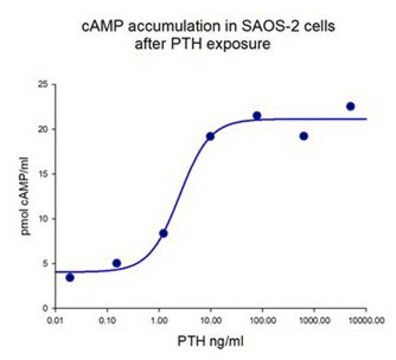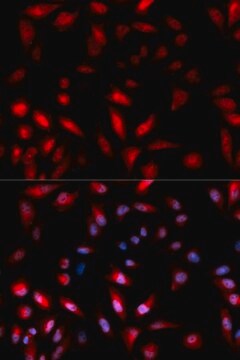SAE0156
Bone Alkaline Phosphatase from human bone osteosarcoma cells
lyophilized, ≥2000 u/mg protein
Synonyme(s) :
ALPL, BAP, Bone ALP, Ostase
Se connecterpour consulter vos tarifs contractuels et ceux de votre entreprise/organisme
About This Item
Code UNSPSC :
12352204
Nomenclature NACRES :
NA.77
Produits recommandés
Description générale
Mammalian alkaline phosphatases are a group of membrane-bound glycoprotein isoenzymes that are attached to the cell membrane by a hydrophobic glycosyl-phosphatidylinositol (GPI) anchor.
The bone alkaline phosphatase isozyme is expressed from the gene for tissue nonspecific alkaline phosphatase which is also expressed in liver and kidney. These three isoforms form the majority of alkaline phosphatases circulating in serum. All three forms share the same amino acid sequence but have different carbohydrate and lipid modifications that provide unique properties according to the source tissue.
Bone alkaline phosphatase is synthesized by osteoblasts, involved in the calcification of bone matrix, but its precise role in bone formation process is still unknown. It is a highly specific marker of the bone-forming activity of osteoblasts. High activity of bone alkaline phosphatase is observed in serum in several bone diseases, such as Paget′s disease, osteoporosis, ricket disease, bone metastatic carcinoma, and others. Physiological bone growth can also contribute to increased levels of bone alkaline phosphatase in serum.
This product is purified from human osteosarcoma Saos-2 cells, an established cell line with high basal alkaline phosphatase activity. Before purification, alkaline phosphatase is released from the cell membrane by enzymatic cleavage of the GPI anchor.
The bone alkaline phosphatase isozyme is expressed from the gene for tissue nonspecific alkaline phosphatase which is also expressed in liver and kidney. These three isoforms form the majority of alkaline phosphatases circulating in serum. All three forms share the same amino acid sequence but have different carbohydrate and lipid modifications that provide unique properties according to the source tissue.
Bone alkaline phosphatase is synthesized by osteoblasts, involved in the calcification of bone matrix, but its precise role in bone formation process is still unknown. It is a highly specific marker of the bone-forming activity of osteoblasts. High activity of bone alkaline phosphatase is observed in serum in several bone diseases, such as Paget′s disease, osteoporosis, ricket disease, bone metastatic carcinoma, and others. Physiological bone growth can also contribute to increased levels of bone alkaline phosphatase in serum.
This product is purified from human osteosarcoma Saos-2 cells, an established cell line with high basal alkaline phosphatase activity. Before purification, alkaline phosphatase is released from the cell membrane by enzymatic cleavage of the GPI anchor.
Définition de l'unité
One unit will hydrolyze 1.0 μmole of p-nitrophenyl phosphate to p-nitrophenol and inorganic phosphate per minute at pH 9.8 at 37 °C.
Code de la classe de stockage
11 - Combustible Solids
Classe de danger pour l'eau (WGK)
WGK 3
Certificats d'analyse (COA)
Recherchez un Certificats d'analyse (COA) en saisissant le numéro de lot du produit. Les numéros de lot figurent sur l'étiquette du produit après les mots "Lot" ou "Batch".
Déjà en possession de ce produit ?
Retrouvez la documentation relative aux produits que vous avez récemment achetés dans la Bibliothèque de documents.
Notre équipe de scientifiques dispose d'une expérience dans tous les secteurs de la recherche, notamment en sciences de la vie, science des matériaux, synthèse chimique, chromatographie, analyse et dans de nombreux autres domaines..
Contacter notre Service technique






